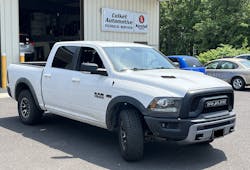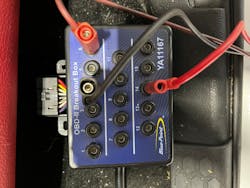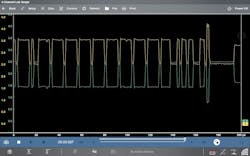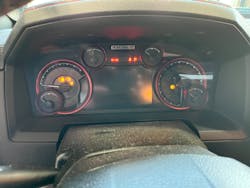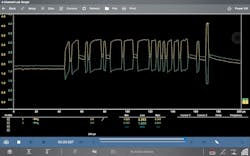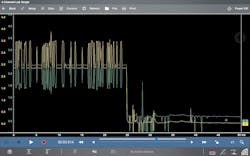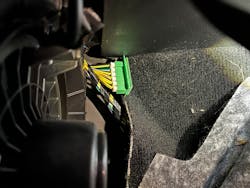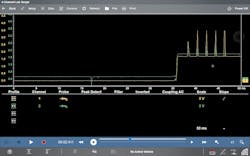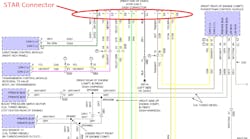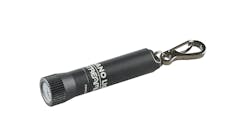What you will learn:
• Beginning the diagnostic process with a customer interview often leads to an efficient one
• Documenting all DTCs and assist in triangulating the location of a communication bus fault
• Implementing a lab scope can allow you to prove a fault rather then simply assuming
2016 Ram Rebel 1500
5.7 Liter Hemi MDS VVT engine
8-speed Automatic 8HP70
Original customer complaint:
"Instrument lights all light up and the transmission shifts hard."
The customer had originally contacted us on the phone to discuss the problem they were having with their vehicle and to inquire if we were able to diagnose the vehicle for them. They had been referred from another shop that knew our capabilities. The customer went on to explain they had the vehicle at two different dealers, two tries for each dealer. The one dealer had gone as far as putting 300 miles on the vehicle without being able to duplicate the problem. The customer was extremely frustrated at this point because every time they picked up the vehicle, the problem would happen within 15 minutes of them driving the vehicle. Typically, the problem would happen on the way home from the dealership. The customer went on to explain that they had paid for the top-level extended warranty through Chrysler due to the potential expense of what could be wrong. So, our job was to diagnose the problem and they would return to the dealer for the repair.
The interview
We always start problem vehicles with an interview to discuss the specific problem the customer is having. We will ask probing questions like: When does the problem happen? Were you in traffic? Were you accelerating? and many more depending on the problem. Remember, the customer may not know the technical terms for describing the problem or the part they think could be the problem, but they do know their car and will do their best to describe the problem it is having. It is up to us as professionals to listen and educate the customer as to what they are describing and to begin formulating a diagnostic strategy.
We were able to determine the vehicle would always begin to have the problem in traffic, mostly on hot days. The instrument cluster indicator lights would all come on. The turn signals would stop working, and you could shut the vehicle off, but it would not restart while the problem was occurring. The most important thing that we found out was that the windshield wipers would come on when the problem was happening and would turn off when the problem stopped.
I suggested to the customer that they take the vehicle back to one of the dealerships and have them go for a test drive with them. The customer was so frustrated at this point with their experience that they insisted that we perform the diagnostics. I know the manager of the local Chrysler dealership, so I said I would reach out on their behalf with our findings so the dealership would know how and what they should be looking for.
The Diagnostic Strategy
We now knew we are dealing with an intermittent problem that will signal us with the wipers turning on when it is occurring. Let’s go check for codes and check Identifix for bulletins and common problems.
We found 52 codes in 20 modules and all the codes are communication codes, except one for a circuit failure in the door handle sense circuit (Figure 2). The code is for the door handle sense circuit is in the Radio Frequency Hub module (which does happen to be part of the CAN C bus). Another clue, but not enough to justify taking apart the driver’s door. Most of the codes point toward the CAN C bus performance or being “off.”
Consulting Identifix resulted in multiple hits, with possible causes all over the board. This information gives us some direction to the CAN C network, but not enough to determine a specific pinpoint test currently. We can see by looking at the network topology that the Can C bus shutting down would explain all the customer complaints. Now it is time to find the root cause.
One of the great things with network diagnostics is that many times we can access the network through the DLC. But first, we need to be able to duplicate the customer's concern at the time of the test. So, we will start by hooking up our oscilloscope to the CAN C bus through the OBDII port. We will use an OBDII breakout box for a quick connection. Keep in mind we either want to use the proper terminal probes or a breakout box so that we do not damage the pins of the OBDII port. Another great part of the breakout box, I can also hook up a scanner at the same time to watch data (Figure 3).
We connected the scope’s ground to pin 4 (chassis ground), channel 1 to pin 6 (CAN C High), and channel 2 to pin 14 (CAN C Low). You can see a nice clean and stable CAN C bus signal. CAN C High is 2.5V to 3.5V and CAN C Low signal is 2.5V to 1.5V (Figure 4). The signal does have some noise but is not enough for concern at this time. Keep in mind everything is functioning properly currently.
We also shut the car off until the CAN C bus went to sleep and checked the resistance of pins 6 and 14 and found that the bus had the recommended 60 ohms of resistance. We know that both terminating resistors are on the network currently.
The Test Drive
We cleared all the codes in the vehicle in hopes that if any of the codes reset, we might see some different information than we had before. We began by driving the vehicle normally (in town and then transitioning to the highway). We made sure to hit stop-and-go traffic, but we were unable to duplicate the customer's concern at this time.
We tried it with the vehicle cold, warm, and hot. We drove the vehicle very lightly and very aggressively but were unable to duplicate the customer’s concern. We needed to get other jobs done in the shop, so we parked the car behind our service bay and let it idle.
We had as many electrical loads turned on as we could to pull the voltage down and stress the vehicle. We watched the voltage dip down to 12.2 volts and the idle picked up to close to 1000 RPM. We kept turning the heated seats and heated steering wheel on as they would turn off on their own. Finally, about 45 minutes later we saw the wiper blades come on (Perfect! Now we are getting somewhere). When we looked at the dash, we could see the gauges were dead and multiple indicator lights were on (Figure 5). We opened the door and the wipers shut off. So, we knew the network had begun to talk again and we most likely wouldn’t see any problems on the scope. We checked our scope pattern and found the pattern to be slightly unstable, but not enough to shut down the network (Figure 6). The pattern indicates that the voltage is fluctuating on the network; within its normal toggling voltage levels. This is the first time that we have seen the problem beginning to impact the network signal.
The Next Step
We continued to stress test the vehicle and were getting the problem to randomly occur, but not for any significant period. We learned that the vehicle's wipers would come on, the hazard flashers still worked, but no turn signals. The vehicle would not come out of Park; the power windows would work, but not the power locks. There was absolutely no information on the cluster; the gauges were dead, and just a few indicator lights. And, if you turned the vehicle off, it would not restart.
All the trouble codes were indicated communication failures or invalid data received from a module. We now were seeing the scope pattern was flat lining at 0 volts (On both CAN C High and Low) (Figure 7). Now that we have seen what we are looking for we can reconfigure the oscilloscope to better catch the glitch.
Scope Configuration
Originally when I set up the scope I had it on .5 volt per division and 20 µS (microsecond) per time division. (Reference Figure 4). These settings will give you 0 to 5 volts and a total of 200 µS (or 200 millionths of a second per screen). It gives great detail but is a very small fraction of time. The chances of actually seeing a problem are very small if you do not have the trace set properly on the scope.
There are so many screens because of all the sampling that has been recorded, and the short period that you are actually looking at will cause you to potentially lose yourself in too much information.
You will notice (in the next image) that I have adjusted the time base on the scope to look at a much larger amount of time; 5 ms per division or a total of 50 ms (milliseconds). By doing this we are looking at a much larger time frame and have a better chance of catching the failure.
We know that the signal drops to zero volts now, so we will set our trace to look for a voltage drop. (Figure 8) (Perfect! We captured the problem). Unfortunately, there is no way to know from the signal what is causing the problem, but we have absolute confirmation it is an issue in the CAN C bus.
The Final Diagnosis
Chrysler products have a star configuration bus (as seen by the topology map from the scanner). The scanner’s topology map is great for a quick reference, but there is quite a bit more information that can be determined from the network topology map from Mitchell 1 ProDemand. Keep in mind this is only 1 page of 5 for this vehicle. But let’s take a closer look and see what we can learn about the network from this image (Figure 9).
We can see that all the modules on the bus are parallel to one another (Not like a series network, where if you lose one module, you will lose all the modules after it). We can see that the CAN C star connector is located at the right end of the dash. This will be our easiest access point for our next test.
I prefer to be more specific when doing a pinpoint test to verify a problem, but this is the next step in the diagnostic process. We begin by getting access to the star connector (Figure 10). Once we have accessed the connector, we will wait for the problem to occur, and while watching the scope pattern. Once the pattern drops off, we will start by disconnecting each two-wire connector. If the problem goes away, the next step is to verify which module is causing the problem.
Got it! The transmission control module was pulling the network down. As soon as we disconnected the transmission control module the network jumped back to life. (Figure 11). So, a faulted transmission control module it is.
STOP! Not yet; we still need to test powers and grounds to the module. We performed these tests when the problem was occurring and clarified that they were demonstrating no deficiencies. We found the rebel module. Unfortunately for the customer, this particular transmission has the TCM inside the valve body (internal).
The Resolution
We contacted the customer and explained what we had found and how we had found it. We also supported this information with screenshots and printouts to show to the dealer. The customer was ecstatic that we had found the problem and was excited to return to the dealer to get the repairs performed.
Never once did they question the amount of the bill because we had found the problem. I encouraged the customer to schedule an appointment as quickly as possible with the local dealership, which they did. Approximately a week and a half later I received a phone call from the customer, who was very distraught over the dealership's responses and the overall customer interaction they had.
They explained to me the dealer wouldn't even look at the printouts we had given them. The dealer responded that the vehicle must exhibit the problem when it was hooked to dealer equipment only. The material we provided meant nothing to them. I told the customer I would go speak with the service manager at the dealership to try and explain how to duplicate the problem.
My conversation with the service manager went better than I expected. He allowed me to speak with the senior technician that was working on the vehicle. I explained to him the vehicle needed to be hot and a heavy electrical load for approximately 1 hour. I left hoping that I had not wasted my time.
Fast-forward a few days and I received another call from the customer. He was so frustrated that they were done with that dealership and asked if I could recommend another one, which I did. This time I spoke to the service writer and conveyed all the information that we had learned on how to duplicate the problem. Again, it, unfortunately, ended up being a waste of my time. Several days later I received a call from the customer who asked if we would perform the transmission valve body replacement job. I explained to them that I would not be able to use their extended warranty and that the bill would have to be paid for. They explained to me that they understood that. They weren’t happy about it, but that they were so impressed with our shop and what we had done for them, they wanted us to at least benefit from the repair (and not the dealer).
We ordered the parts, made the repairs, programmed the TCM, and verified the repairs. In the end, the customers had taken their vehicle to 3 different dealerships (a total of 6 times) and couldn’t even get a conclusive diagnosis. They made it very clear they would never buy another Chrysler product (not just because of the problems they had, but more importantly the lack of customer service).
They were so impressed that we were able to diagnose and repair the vehicle accurately that they have begun to bring their other cars to us. And finally, they gave us one of the best online reviews the shop has ever received! But it wasn't magic or luck. It was a solid understanding that allowed us to draw a correct diagnosis. Unfortunately, something the dealerships failed to employ on those occasions.
